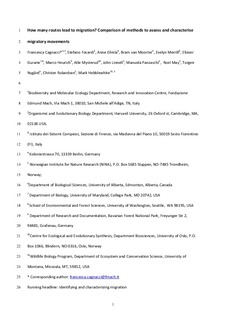| dc.description.abstract | Summary 1. Decreasing rate of migration in several species as a consequence of climate change and anthropic pressure, together with increasing evidence of space-use strategies intermediate between residency and complete migration, are very strong motivations to evaluate migration occurrence and features in animal populations. 2. The main goal of this paper was to perform a relative comparison between methods for identifying and charact erizing migration at the individual and population level on the basis of animal location data. 3. We classified 104 yearly individual trajectories from five populations of three deer species as migratory or non-migratory, by means of three methods: seasonal home range overlap, spatio-temporal separation of seasonal clusters and the Net Squared Displacement (NSD) method. For migr atory cases, we also measured timing and distance of migration and resi- dence time on the summer range. Finally, we comp ared the classification in migration cases across methods and populations. 4. All methods consistently identified migration at the population level, that is, they coherently dis- tinguished between complete or almost complete migr atory populations and partially migratory populations. Ho wever, in the latter case, methods co heren tly classified only about 50% of the sin- gle cases, that is they classified differently at the individual-animal level. We therefore infer that the compariso n of methods may help point to ‘less-stereo typed ’ cases in the residency -to-migration continuum. For ca ses consistently classified by all methods, no signifi cant differences were found in migration distance, or residence time on summer ranges. Timing of migration estimated by NSD was ea rlier than by the other two methods, both for spring and autumn migrations. 5. We suggest three steps to identify improper inferences from migration data and to enhance understanding of intermedia te space-use strategies. We recommend (i) classifying migration behaviours using more than one method, (ii) performing sensitivity analysis on method parame- ters to identify the extent of the differences and (iii) investigating inconsistently classified cases as these may often be ecologically interest ing (i.e. less-stereotyped migratory behaviours). adehabitat, hom e range overlap, movement patterns, Net Squared Displacement, red deer, reindeer, residence behaviour, roe deer, spatial clusters | nb_NO |
